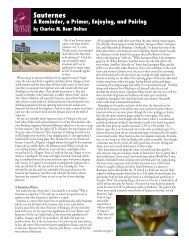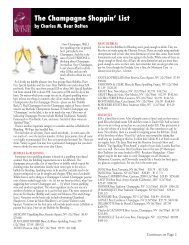What I Tasted on My Spring Break - SPEC's Liquors
What I Tasted on My Spring Break - SPEC's Liquors
What I Tasted on My Spring Break - SPEC's Liquors
Create successful ePaper yourself
Turn your PDF publications into a flip-book with our unique Google optimized e-Paper software.
www.specs<strong>on</strong>line.com<br />
(c<strong>on</strong>tinued from page 1)<br />
inventory to sell off our racks when the<br />
vintage is shipped. The other is to offer<br />
the best possible prices <strong>on</strong> rare and<br />
expensive wines to our Bordeaux-loving<br />
customers. As we get c<strong>on</strong>firmati<strong>on</strong>s <strong>on</strong><br />
our orders, we offer the wines out for sale<br />
as futures, a way to buy wines that haven't<br />
even been bottled yet. On the wines we've<br />
tasted and like and <strong>on</strong> wines with great<br />
track records, we buy as much as we are<br />
allocated, often at several different prices.<br />
If our customers get hot <strong>on</strong> a particular<br />
wine and we run short or sell out, we go<br />
back and buy more, usually at a higher<br />
price. We then make a sec<strong>on</strong>d offering<br />
reflecting that higher price.<br />
In order to open the futures opportunity to<br />
as many customers as possible, Spec's<br />
offers Bordeaux futures sales <strong>on</strong> bottles and<br />
three-packs as well as the standard twelve<br />
bottle cases. While the price advantage is<br />
not as substantial in the smaller lots, there<br />
is still an edge over what the wines will sell<br />
for <strong>on</strong> arrival. But far and away the main<br />
benefit here is the guarantee of availability.<br />
Single-bottle and three-pack pricing is<br />
available <strong>on</strong>ly <strong>on</strong> 750ml bottles of dry reds<br />
and whites and both <strong>on</strong> 375ml and 750ml<br />
bottles of most Sauternes.<br />
So what's all the fuss about Just that the<br />
futures market insures the savvy Bordeaux<br />
lover a way to buy his favorite wines at the<br />
best prices they'll likely ever sell for, and a<br />
way to insure himself that he will actually<br />
get some of the rarer wines that may never<br />
make it <strong>on</strong>to a rack or shelf in the store.<br />
Is my<br />
1996 Margaux<br />
in the<br />
stage<br />
dumb<br />
“When will my 2001 Ducru enter the<br />
dumb stage When will it emerge” “Will my<br />
1989 Leoville las Cases ever emerge from the<br />
dumb stage” “D<strong>on</strong>’t open that yet, it’s still in<br />
the dumb stage.”<br />
<str<strong>on</strong>g>What</str<strong>on</strong>g>’s the dumb stage It is a period in a<br />
wine’s development where the wine is<br />
undergoing reductive changes in the bottle<br />
as it sheds some of the fresh fruit of its<br />
(c<strong>on</strong>tinued p. 3)<br />
Chateau<br />
Margaux<br />
Bordeaux Report (c<strong>on</strong>tinued from p. 1)<br />
and Bordeaux Millesimes to name a few. I also taste at<br />
many chateaux whose wines are not shown at the<br />
UGC tastings. Each year I go to all the first growths<br />
and many of the sec<strong>on</strong>ds where we taste more than<br />
just that wine. There are sec<strong>on</strong>d and sometimes third<br />
wines to taste as well as associated properties. At<br />
Mout<strong>on</strong>, we also taste Clerc Mil<strong>on</strong> and d’Armailhac, and<br />
at Lafite we also taste Carruades and Duhart Mil<strong>on</strong>. At<br />
Haut Bri<strong>on</strong>, we taste La Chappelle de la Missi<strong>on</strong> (the 2nd<br />
vin of Ch. La Missi<strong>on</strong> Haut Bri<strong>on</strong>), Bahans Haut Bri<strong>on</strong> (the<br />
2nd vin of Ch. Haut Bri<strong>on</strong>), Latour Haut Bri<strong>on</strong>, La Missi<strong>on</strong><br />
Haut Bri<strong>on</strong>, and Haut Bri<strong>on</strong> as well as Laville Haut Bri<strong>on</strong> (the<br />
white wine of La Missi<strong>on</strong>) and Haut Bri<strong>on</strong> Blanc. All in all at Haut<br />
Bri<strong>on</strong>, we taste seven wines from each vintage and we usually taste two<br />
vintages.<br />
This year, the opportunity to re-taste past vintages served me well. The 2001<br />
Ch. Margaux wine had not shown well in 2002 or 2003 and I was frankly a bit<br />
worried that I’d made a mistake in buying it. <strong>My</strong> purchase was based <strong>on</strong> Margaux’s<br />
superb track record and assurances by Margaux director Paul P<strong>on</strong>talier that the wine was just<br />
backward and that it would come around. It finally did come around and is now showing very well,<br />
just in time for release.<br />
At dinners in restaurants and during visits and dinners at chateaux, we always drink older, usually mature<br />
wines. The last few years our Bordeaux dinner wines have included many great wines from 1985, 1986,<br />
1988, 1989, 1990, 1993, 1994, and 1995. We have had the odd 1982 and even a couple of 1991s. The<br />
1991s from Ch. Latour, Ch. Parenchere, and Ch. Segur de Cabannac were shockingly good wines from a<br />
frankly forgettable, very wet vintage.<br />
All this tasting (and drinking) leads to a familiarity with a property that transcends vintage variati<strong>on</strong> as well<br />
as to an understanding of each vintage and where its sub-regi<strong>on</strong>al strengths and weaknesses are. It also<br />
reinforces, for me at least, the noti<strong>on</strong> that I’d usually rather drink the wine from chateau I really like in a<br />
merely good or even mediocre vintage than wine from an also ran property in even a great vintage.<br />
1993 and 1994 were lightly regarded, rain affected vintages that still made very nice, elegant, mediumweight<br />
clarets. Most from the lesser appellati<strong>on</strong>s have already been drunk and that is a good thing as most<br />
of them wouldn’t have lasted. The best wines of these vintages (the top classified growths) are very pretty<br />
wines that in many cases are drinking very well now. Whenever I see good 1994s <strong>on</strong> wine lists, I am<br />
interested. They are often very good values and are always under appreciated.<br />
1995 was a great warm year that made fine wines all over Bordeaux. These were big rich wines somewhat<br />
in the style of 1982 and 1990 featuring ample fruit and flavor with good ripeness and a fairly low level of<br />
acidity. The 1995s tasted good <strong>on</strong> release and while they did descend a bit into the “dumb stage” (please<br />
see side bar The Dumb Stage at left), it was not a deep descent and the wines were enjoyably drinkable.<br />
Many of the age-worthy wines have now emerged and blossomed. While the first growths need a bit more<br />
time for optimum drinking, many of the other classified growths from 1995 are drinking beautifully. Even<br />
a number of petite chateaux are holding up nicely.<br />
1996 was, if you believe James Suckling of the Wine Spectator, a disappointing vintage. Or, if you follow<br />
Robert Parker, 1995 was the greatest Cabernet Sauvign<strong>on</strong> vintage in Bordeaux since World War II. Parker<br />
is correct. While the Merlot-dominated right bank appellati<strong>on</strong>s (Pomerol, St. Emili<strong>on</strong>, etc.) yielded many<br />
very good wines in 1996, it was the Cabernet Sauvign<strong>on</strong>-dominated left bank appellati<strong>on</strong>s (Graves, Medoc,<br />
Margaux, St. Julien, Pauillac, and St. Estephe) that had the potential to make excellent and even<br />
outstanding wines in 1996. I still remember tasting the outstanding 1996 Ch. Margaux in the chateau and<br />
being momentarily transported by the wine. The also outstanding 1996 Ch. Latour out of barrel was so<br />
intense that it was almost painful to hold it in the mouth. All the better 1996 wines were excellent from<br />
the barrel and were excellent <strong>on</strong> their release in 1998 and 1999. Most of the Cabernet-based wines had<br />
enough intensity and acidity that they have slipped firmly into the dumb stage. They are not undrinkable<br />
now but will be so much better with a few more years in the bottle that it seems a shame not to hold them.<br />
1997 made pretty wines that emphasized fresh fruit and perfume with a classic weight and structure. They<br />
are not blockbusters and there was some unevenness in quality attributable to uneven ripeness due to an<br />
extended, uneven flowering period. Some clusters (especially Merlot in St. Emili<strong>on</strong>) had ripe grapes with<br />
some green grapes mixed in so a good triage was important. The 1997s also had the problem of being<br />
released as futures at prices too high for the quality, coming immediately after the excellent 1996s. Since<br />
there have been no price increases (and in fact some discounting) <strong>on</strong> the 1997s from the time they were<br />
sold as futures, the vintage is now reas<strong>on</strong>ably priced and drinking very well. 1997 was an excellent to<br />
outstanding year for the sweet wines from Sauternes and Barsac.





